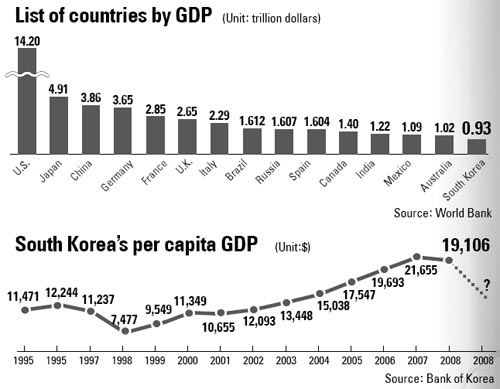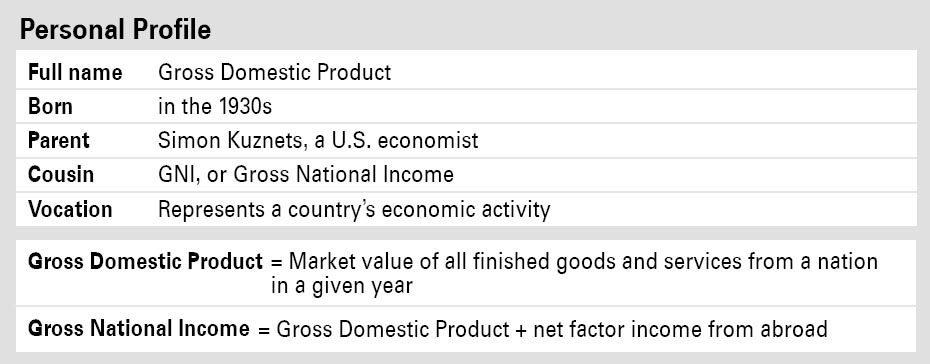What is the Gross Domestic Product?

It’s the Gross Domestic Product, which is a measure of the overall economic size of a country in a given year. It is an influential economic indicator, and it is calculated by combining the value of all finished goods and services produced in a country in a given period of time. Technically, it is based on private consumption, government spending, private investment and net exports. It was invented in the 1930s by American economist Simon Kuznets, who later received the Nobel Prize in economics in 1971 for, yes, creating the GDP.

Joseph Stiglitz, center, a Nobel laureate and Columbia University professor, presents the results of a study on the GDP at a forum in Busan Oct. 27-30. Provided by Statistics Korea
The difference between the two is that GDP can include goods and services produced by foreigners as long as they use domestic labor and domestic capital. It excludes the things produced by people outside the country.

Until the 1990s, GNP was more widely used than GDP - students learned about GNP, but not GDP. However, the influence of the GNP has quickly declined because globalization has increased trade between countries as well as the number of businesses operating in countries all over the world.
In fact, many experts say that a figure that is based only on what a nation’s citizens can produce, and that excludes products made by foreign companies, is no longer a realistic way to measure the actual size of a country’s economy.
Instead, GNI, or Gross National Income, is now frequently used along with GDP because it is assumed to be a suitable measure of a country’s income level. The GNI is measured by adding the GDP to net factor income.
The big deal about the GDP
Sounds complicated, right? So what’s the big deal? Well, GDP is the reason that people are always so impressed with China’s economic growth, just as they were with South Korea’s economic growth just over a decade ago.
South Korea earned the nickname the “Miracle on the Han River” because its GDP rose more than 8.7 percent per year for almost 30 years beginning in 1960. Its GDP rose from $21.5 billion in 1975 to $230.5 billion in 1989, according to the Bank of Korea.
China is now enjoying a similarly high rate of growth in its GDP of around 9 percent annually, and it is already the world’s third largest economy. If the country continues to grow at such a fast pace, it will soon surpass Japan, which has the second highest GDP in the world, and it could catch up with the U.S., which has the world’s highest GDP, by 2020. If that happens, people expect that China will assume the hegemony the U.S. has long enjoyed as the world’s largest economy. You see, the power of a country is solely dependant on its GDP.
South Korea was recently ranked the 15th largest economy in the world by the World Bank based on the size of its GDP in 2008. Its GDP last year was $929.1 billion.
That figure is a retreat from its position as the 11th largest economy in 2004, the 12th in 2005 and the 13th in 2006 and 2007, but it is still a remarkable improvement compared to what it was right after the 1950-53 Korean War between South Korea and North Korea. The North’s per capita GDP, or GDP divided by total population, is only 6 percent of the South’s per capita GDP.
South Korea’s per capita GDP was $19,106 last year. Although the country’s desire to achieve a per capita GDP of $20,000 this year is likely to be dashed by the ongoing economic slump, many expect that the figure will continue to rise in the years to come.
Among other things, the rapid growth of South Korea’s GDP over the past several decades has aroused national pride for many Koreans. That could explain why there is so much news about South Korea’s economic growth in local newspapers. South Korea is also one of the few advanced countries whose GDP is returning to a level that is similar to what it was before the 2008 financial crisis began. It is among a handful of countries expected to record positive GDP growth this year.
GDP and happiness
Many people believe there is a connection between GDP and a country’s development. For instance, studies point to a high reverse correlation between GDP growth and an increase in the crime rate. In 1995, when South Korea’s GDP growth was 9.2 percent, the crime rate had grown only 1.9 percent from the previous year. But in 1998, when the GDP fell 6.9 percent amid the Asian financial crisis, the crime rate increased 11.16 percent from a year earlier.
But there are also people who question whether GDP can be used as an indicator for development. The logic is that quantitative growth (an increase in the number of the goods and services) does not necessarily translate into qualitative growth (improvement in one’s quality of life). Although South Korea is 15th in the world in economic size, it does not mean the country will rank the same in happiness. Ironically, studies show that very poor countries such as Bangladesh and Bhutan often top the list of countries with the happiest people in the world.
There is also doubt about the value of measuring a country only by its GDP, because negative factors such as environmental degradation contribute to the GDP as long as they aid industrial production. In that sense, Robert Kennedy, a former U.S. Attorney General and the brother of former U.S. President John F. Kennedy, once said that GDP “measures everything, in short, except that which makes life worthwhile.”
An alternative to GDP
With that in mind, many countries have begun to search for an alternative to GDP. This movement gained momentum with the creation of an international study on the issue commissioned by French President Nicolas Sarkozy in February of last year. The research group was composed of renowned economists from several countries and named the Stiglitz Commission after its leader Joseph Stiglitz, a Nobel laureate in economics and a Columbia University professor.
The commission’s efforts were recently discussed here when the country hosted the Organization for Economic Cooperation and Development World Forum in Busan in October. The event was co-organized by Statistics Korea and took place Oct. 27-30. It allowed representatives from countries across the globe to discuss the results of the committee’s findings and related research.
South Korea is an active participant in the search for an alternative to the GDP. President Lee Myung-bak said during the OECD forum that the country will work to create other economic indicators, such as a “green growth” index, which gets its name from the policies initiated by the Lee administration to improve the economy through things that are good for the environment.
Experts say it will not be easy to find an alternative to the GDP, but if we remember that is what Kuznets, the father of the GDP, might have wanted, it is a worthwhile task.
“Distinctions must be made between quantity and quality of growth, between costs and returns, and between the short and long run. Goals for more growth should specify more growth of what and for what,” Kuznets wrote in 1962.
By Moon Gwang-lip [joe@joongang.co.kr]
JoongAng daily Hot issue
- Lee offers apology for Sejong issue in live TV debate
- World markets wait on Dubai’s debt crisis
- Spy drama shoots in central Seoul
- Korean convicted of racism for 1st time
- Korail hit by ticketing crash, industrial action
- Yangsan mayor hangs himself ahead of probe
- Seasonal sales underway
- Majestic migratory birds alight











with the Korea JoongAng Daily
To write comments, please log in to one of the accounts.
Standards Board Policy (0/250자)